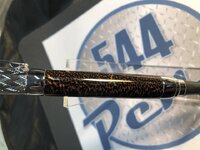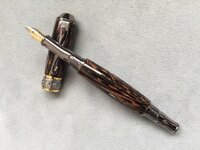Bope
Member
I started making some pens with black palm. It is a nice looking wood but a nightmare to finish. I am using a CA finish. There usually is an inclusion like a small crack somewhere on the blank after turning. This shows up once I start sanding the finish. Once I sand with 1500 grit the inclusion becomes obvious as a shinny line in the finish. I have tried filling the inclusion with thin CA but that just ends up making a broad high spot. This last time I tried a couple more coats of med CA then decided to sand until I got to the top of the CA filling the inclusion. Since this was taking forever with 1500 I tried some 1000. The problem now is the inclusion wasn't filled above the surface of the wood and the swarf settled into the low spot and is now small white dots. Interestingly this never happened with the 1500 grit. How do you fill small cracks or inclusions?


